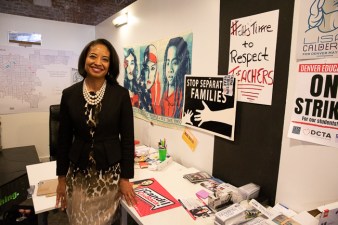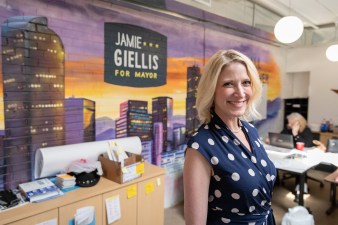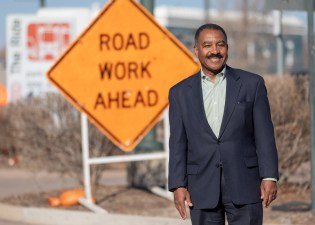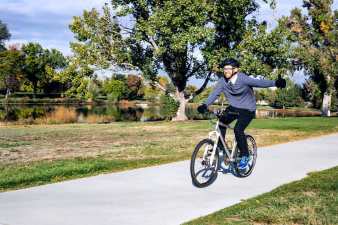Candidate and Mayor Michael Hancock: The Streetsblog Interview
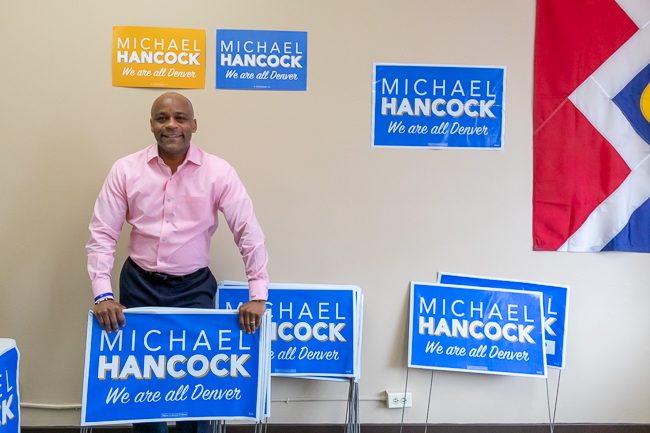
This is the last of a series of interviews with candidates for Denver mayor in the May 7, 2019 municipal election. Editor Andy Bosselman conducted and condensed each interview. Several members of the Streetsblog Denver board of directors advised Bosselman in choosing the candidates and the subject matter covered. Other interviews include: Sen. Penfield Tate, Jamie Giellis, Dr. Lisa Calderón and Kalyn Heffernan.
Q: Your challengers say that under your administration:
- Housing prices have risen dramatically
- Homelessness has grown
- The rapid pace of new development is changing the city and some neighborhoods too much
- You haven’t moved fast enough on improving walking, biking and transit
- And your three-year Denveright planning process didn’t engage the public meaningful ways
Why should Denver voters re-elect you over the candidates who say they would do a better job at addressing these issues?
A: Armchair quarterbacking is the easiest job in the room. It’s easy because you’re off the hook, you’re not accountable to anyone. It’s easy to make those snap judgments. But here’s the reality.
Growth
This growth that hit Denver so fast, and at such a volume: I talk to my colleagues around the country, they look at it amazed that Denver is still standing. And not only still standing, but still thriving. You just don’t see a hundred thousand people come somewhere in a matter of eight years like that.
Homelessness
[In other cities] you do not have the perfect storm around those elements that contribute to homelessness in the unprecedented way in which we’ve had it. We already had homelessness in the city of Denver. But the reality is, with our kind of growth, some people came here without jobs … and the money ran out pretty quickly. Also, with the epidemic that we face, methamphetamines in Denver, has just been absolutely challenging. These are not excuses. These are reality.
Housing
As a city with the massive growth that we’ve had, … not enough housing is some basic economics, supply and demand.
Response
We are responding as fast as a government can. … If you look at our history as an administration, we did begin to address [these issues] as early as 2012:
• Three by Five. [A 2013 plan to build three thousand housing units for workers in five years]
• General fund money for housing
• [The] Mobility Action Plan
• And engaging around the Comprehensive Plan
We were still within [the timeframe of the Comprehensive Plan developed in 2000], but we [acknowledged that we] were growing too fast, this is unusual. Let’s [start] the planning for the next 20 years.
[Denveright’s] 25,000 pieces of public input says a lot to me. The reality is that we leaned in, and the public leaned in. I don’t know what threshold [opponents] look for, but to me it sounds [like] political speak.
Q: What’s your vision for Denver’s transportation future?
A: I look forward to the day when we go full throttle in terms of our multi-modal vision for the city of Denver.
Obviously, we roll out Vision Zero. We gotta make our corridors safer. We’ve got to be always committed to having zero fatalities.
We’re in the midst of a transformation. Let’s face and acknowledge the fact that this city, one, has grown, and two, we’re in the 21st century. We should become more multimodal.
It is a city built for cars. We are transforming a culture, which is the hardest thing to do when it comes to organizations, or society or a people.
My goal, and my vision, is that we will look 10 to 15 years from now and Denver has fully deployed and implemented its multi-modal vision for the city.
- Bike network is completed
- Sidewalk network is completed
- We have adequate transportation and
- We figured out that first- last-mile strategy [for public transit]
It’s reliable. It’s convenient. It’s affordable. And I don’t have to think twice. Like when you’re in New York and D.C., about trying public transit or different modes of transportation. That’s ultimately my hope and vision for Denver.
Q: Tell me about the last time you took public transportation.
A: The last time I took public transportation, let’s see here, was probably in Washington D.C.
Q: How long ago was that?
A: Probably within the last year.
Q: In your time as mayor, are there accomplishments related to pedestrian safety, bicycle infrastructure, or public transportation that you’re proud of?
A: First thing, we’re the first administration to really start rolling out a bicycle network. We’ve now committed 125 miles in the next five years. But a lot of the infrastructure you see today happened during my administration.
[We] expanded [the B-Cycle bike share] system, which we’re evolving. I see it becoming less of a government-operated program and more of a market-driven program.
You also see us … address and deal with the scooter revolution. By saying, “Whoa, whoa, we’re not going to just do this willy nilly in Denver. We’re going to find a way to deploy these scooters in a smart fashion that keeps people safe.”
I’m proud of ushering in the bicycle network revolution in Denver. And the transformation of this more multi-modal thinking. We’re the ones pushing this from my administration.
Q: About the Department of Transportation and infrastructure that your administration proposed April 2: If voters approve the needed charter change, what would the department do and how would that help the city?
It puts into perspective the real focus of mobility and transportation infrastructure in our city. It’s not just what you see on the surface, it’s also [what’s] underground. It has been elevated to a real Cabinet-level position to allow us to zero in our resources.
If you’re going to commit $2 billion [for Denver’s Mobility Action Plan], we can birds-eye-view those resources, manage them appropriately, and not have staff entangled with different assignments within the whole Department of Public Works. It’s really just putting the emphasis and the focus more squarely on mobility and transportation.
Q: This morning [March 28] at an RTD press conference about transit upgrades coming to Colfax, you brought up the city’s mode shift goals. 73% of trips within Denver are made in single-occupancy vehicles. The city’s goal is to get that number down to 60% by next year and to 50% by 2030. You’re clearly not going to hit the mark for next year, so how are you going to catch up?
We’ll adjust. What we didn’t count on, and what we are now fully aware of again, is how difficult this culture [of driving] is.
And at the same time, you’ve got to make sure people feel comfortable. As I said today, reliability is critical. People have to know that they’re going to get to where they need to go on time. I’m not going to have to worry about waiting for a bus or a train to pick up my kids, or grab the groceries or get home.
The reality is that you have to have goals to shoot for. The reality is that this 73 percent is not sustainable for Denver. Not at our growth rate. We’ll all be choked out in congestion. We’ve got to begin to create those opportunities for people around Denver.
Q: The Denveright plans, which support your $2 billion Mobility Action Plan, call for the creation of a network of high-frequency transit corridors that would improve the existing transit service. Tell me about that, and how you will pay for it.

A: It’s a combination of working with RTD, and really impressing upon them the need for greater frequency in those corridors. How often are we running trains [and buses]? What are their intervals?
We’re also going to bring greater density at those [transit-oriented development] stops, so there are going to be more [passengers]. We’re breaking ground almost monthly on a new development at those sites. The density strategy around TODs is happening and that’s exciting.
The other thing is, as we see RTD hit its limits, the question becomes for Denver: What’s our willingness to invest in other modes of transportation. [For example,] other transit … to help supplement what RTD is doing.
But we do believe those are better for regional conversations, as opposed to just Denver doing them. Particularly those major corridors that are regional, [along] I-25, and I-70 and Colorado. Many of the mayors and commissioners, we’ve had informal conversations. [After upcoming elections,] we’ll have more of a forward-looking conversation.
Q: Some of the other candidates have called for creating a separate transit system. In cities like Seattle and Boulder, they pay the regional transit provider for additional service within the city. Is that something that’s being considered?
A: Absolutely. I expect to carry that conversation forward. The leadership in Denver, and of course Aurora, has to get its new mayor elected, so we can resume those conversations. I expect to do that.
Q: So you don’t want to create a new transit system specific to Denver?
I don’t think it makes sense just to do Denver.
People are coming into the city. They’re contributing to our single-occupancy vehicle trips. So how do we create that regional network, so people feel comfortable with the reliability, the convenience and the cost of coming in from various other surrounding cities to work in Denver every day?
Q: In 2015, Denver joined the Vision Zero movement when you committed to a goal of ending all traffic fatalities and serious injuries by 2030.
- In the last few years, traffic fatalities have actually increased.
- According to the Denver Streets Partnership, making the needed bike and pedestrian changes would take 100 years to achieve at current funding levels of about $5 million per year. Roughly $40 million per year is needed to meet the goal by 2030.
If voters re-elect you, what are your plans to meet the city’s Vision Zero goals, and how will you pay for it?
A: Do we get to 40 million dollars a year? I don’t know. The reality is, you always have the opportunity costs. We want to make the proper investments.
In terms of fatalities going up, … 2015 or 2016 is the time I made the pledge. So we’re about a year and a half into the program. We’re ramping up, and we’re going to more full-throttle into it.
Federal Blvd, for example, we’re battling at the state level: “Why won’t you let us implement these changes that will keep people safer?” What people don’t realize is that a lot of these corridors, like Federal, like Alameda, are state highways. We have to navigate the politics at the state level. We’re doing those things.
In terms of resource allocation, we’re there in terms of a willingness to do it. We’ve just got to do it in a way that allows us to get there in a way that does not impact our ability to care for all the other responsibilities that we have.
Q: For $1 million per year, the Denver Streets Partnership says quick, low-cost pedestrian safety improvements could be made right away. These things are as simple as using paint and plastic posts to narrow intersections. Some of those things have already been done. But why aren’t they being done everywhere along the city’s most dangerous streets?
A: I’m not gonna say I’m the technical expert to tell you why we’re not doing certain things. I can almost promise you that Public Works has looked at these things. They have to abide by certain standards. It’s a more complicated explanation than just going out and throwing paint and plastic barriers up.
When we have not communicated properly with communities, where we have changed roads… We saw this recently in Southeast Denver, when we put in bike lanes and a two-lane road went to one lane. We had accidents. We had people calling, “What the hell did you just do to my street?”
It may seem simple … but at the end of the day, the engineers have to make sure that we’re keeping people safe. And we [must] bring these changes along thoughtfully, where we’re also informing the community. They do take time.
Q: At Bicycle Colorado’s Moving Forward conference in January, Janette Sadik-Khan [Streetsblog interview], who helped New York transform its streets and mobility options under Bloomberg, spoke. She talked about how they got a lot of pushback around changes to the streets for Vision Zero, adding bike lanes and creating plazas. The media and the public really called for her head and Mayor Bloomberg stood by her. Many of these changes, especially if they remove parking, really get people riled up. I know that you need to engage people and communities, but they’re going to push back. So when is time for leadership?
A: I’ll tell you, it’s not about pushing back. I come from a community organizing background. I was on City Council. Now, as mayor, I’ve made decisions where the community has pushed back.
We’re in the midst of a cultural transformation when it comes to multimodalism in Denver.
But if we believe we have the right information and data, and we’ve done right in terms of informing people, and it’s the right move, we have to go forward.
You’re going to have pushback, particularly motorists who are like, “Why are we dealing with these bicyclists on these roads?” “You just took parking away.” “The roads are narrower.” “I don’t like it.”
We understand that. We have been tenacious. And I’ve supported Public Works.
This is really about community awareness. When you’re making these type of changes on the street, my biggest concern is to make sure that the community is aware these changes are going to happen.
Q: One of the complaints about recent development is that the new buildings are ugly. Denver is a beautiful city but much of the development has come in the form of cheap, three- to seven-story stick-frame apartment buildings. They all look the same and when people think of great cities, those buildings are not what come to mind. I know that Denver doesn’t have a design review process, but given that the city needs to continue building new housing, do you have any plans to address the design problem?
A: Yes, actually [the 2040 Comprehensive Plan] includes a recommendation of a design review process. I agree there have been some ugly buildings built in Denver over the years and I think it was because of the absence of a design review process.
Q: Do you think it will be used as a tool to stop development?
Hopefully not. I don’t think so.
If you have a design process that is fully about engaging the community … if you include people early enough and often enough, then when it comes time to sell the project, they feel like they own more of the project.
